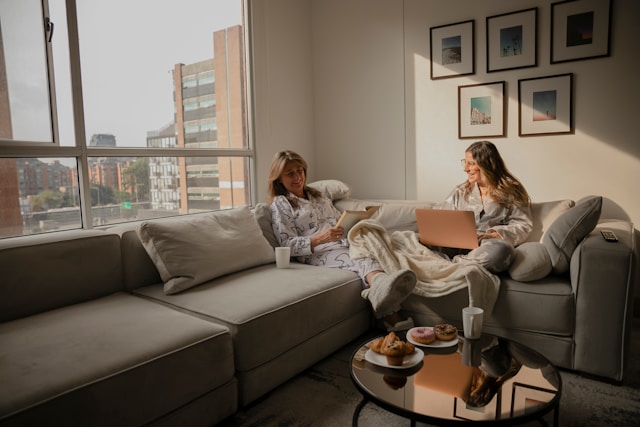It’s one thing to be at home, and another to actually feel relaxed and restored by spending time there.

With the world constantly demanding your energy, your space should feel like somewhere you can fully exhale. Of course, rest doesn’t just happen because you’re off the clock. Your environment plays a huge role in how easily your mind and body can switch off. Here’s how to shape a home that doesn’t just look nice, but quietly helps you rest, recharge, and breathe a little deeper without even realising it.
1. Choose lighting that softens the mood.

Harsh overhead lights can keep your nervous system wired, even when you’re trying to wind down. Swapping to warm bulbs, adding floor lamps, or using dimmers can change the whole energy of a room. Low, ambient lighting tells your brain it’s safe to relax. You’ll be surprised how quickly you start to feel calmer when your space stops mimicking a waiting room and starts feeling more like an evening sanctuary.
2. Let scent work in your favour.

Our brains link scent with memory and mood more than we realise. Lighting a subtle candle, using a calming essential oil, or even just freshening the air can completely change how your space feels. It’s not about turning your home into a spa—it’s about creating an atmosphere your body associates with calm. As time goes on, the right scent becomes a cue: this is where we slow down now.
3. Keep one area strictly for resting.

If you do everything—work, scroll, eat—in the same corner, your body forgets how to relax there. Try to dedicate at least one space for doing nothing: no laptops, no chores, just softness and stillness. It could be a reading chair, your bed, or a quiet nook. Having a spot that’s purely for rest helps your mind shift gears faster. The space starts to carry a different energy because of how you use it.
4. Reduce visual noise.

Clutter doesn’t just affect how a room looks—it affects how you feel in it. Too much visual stimulation can make it harder to switch off mentally, even if you don’t realise why. You don’t have to go full minimalist. But having clear surfaces, hidden storage, or even just fewer “bits” out at once can make a big difference in how mentally restful your home feels day to day.
5. Add softness where it matters.

Rest isn’t just mental—it’s physical too. Blankets, rugs, soft cushions, or even just a pair of cosy socks by the door can tell your body it’s time to unwind. Little pockets of comfort make your space feel lived in and loved. You don’t need a full makeover, just touchpoints that feel gentle, warm, and grounding to come back to.
6. Let nature in, even a little bit.

Plants, sunlight, fresh air—these things put the nervous system into a calmer state without you doing anything. A few low-maintenance plants or keeping the blinds open during the day can have a bigger impact than you’d think. If you don’t have access to much nature, even photos, soft natural colours, or textures like wood or linen can give your space that calming, grounded feel. It’s about creating cues that signal peace.
7. Keep things you love where you can see them.

Sometimes we decorate for what looks good, not what feels good. However, having visual reminders of things that make you feel safe, nostalgic, or happy can instantly change your mood in the right direction. Maybe it’s photos, a piece of art you picked yourself, or just your favourite book sitting in plain view. Let your space reflect who you are, not just what trends say is “aesthetic.”
8. Cut down on noise where you can.
 Source: Unsplash
Source: Unsplash Background noise from the street, appliances, or even TV left on too long can quietly wear you down. Soundproofing might not be realistic, but softening your space helps—curtains, rugs, and closed doors can reduce noise more than you’d think. Try swapping constant noise for gentle sounds sometimes: quiet music, nature sounds, or even just silence. A quieter home doesn’t mean boring; it just means your brain finally gets to stop scanning the room for what’s next.
9. Create transitions between your “on” and “off” time.

If you work from home or have a busy household, your brain needs clearer signals that it’s okay to stop. Changing clothes, putting your phone in a drawer, or lighting a candle when you’re done for the day are tiny but powerful cues. Your space starts to feel like a partner in your rest—not something you have to fight against. These rituals tell your system: it’s time to shift gears, even if the walls haven’t changed.
10. Don’t underestimate scent-free freshness.

Sometimes, rest starts with the basics. Opening windows, washing your sheets more often, or just giving your space a proper clean can completely change how it feels. There’s something deeply calming about a room that smells like air and quiet. You don’t always need incense or candles—sometimes the absence of heavy smells is the reset your senses need most.
11. Make rest easy, not effortful.

If your blanket’s across the room or your comfy clothes are buried in a drawer, you’re less likely to use them. Try placing things you associate with rest within reach—where they gently invite you to slow down. It’s about making stillness convenient. The fewer barriers between you and rest, the more likely you are to actually take it when you need it.
12. Let your space evolve with you.

What helps you rest might change depending on your season of life. Maybe you need more quiet now than before, or fewer decorations, or more softness. Let your space change with you. Your home isn’t just a backdrop. It’s a tool. When it reflects how you want to feel—calm, cared for, safe—it stops being a place you return to, and starts being a place that returns you to yourself.




